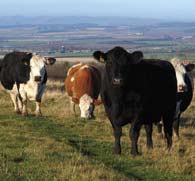Reseeding boosts beef output by £100 a head

Reseeding old grassland with a mixed ley of ryegrasses, chicory and clover can dramatically improve liveweight gains and improve beef returns by more than £100 a head.
Those are the findings of Rob Powell, of Powell Bros, Blaenbwch Farm, Builth Wells, who has seen liveweight gains in his store cattle increase by 100kg a head as a result of a proactive grassland reseeding regime.
The upland farm in Powys consists of 149ha (370 acres) of land used to rear sheep and beef cattle. Mr Powell typically overwinters his sheep on swedes which are grazed from January through to April.
This land is then either put to whole-crop cereals to reduce winter feed costs, or is reseeded for grazing and silage. New leys are established on a rotational basis using two separate grassland seed mixtures from Wynnstay to ensure swards remain as nutritious and productive as possible.
The farm rises to more than 1200ft, with many fields too steep for silage making. The farm’s upper slopes are seeded using Imperial, which contains a mixture of five different late perennial ryegrasses plus a selection of white clovers and chicory. By choosing later maturing varieties, a healthy pasture is available for grazing well into autumn, without the risk of the grasses going back into head.
On the more accessible land, Squire is sown to provide a mixture of red clover and hybrid ryegrasses. The resulting sward provides two cuts of silage a year and still allows lambs to be finished quickly without the need for excessive winter feeding.
On average 15% of the land at Blaenbwch is reseeded each year, and this strategy is paying dividends. “I didn’t realise just how beneficial reseeding could be until I started finishing cattle on another farm that I recently acquired,” Mr Powell explains.
Last year, Mr Powell bought an additional 121ha (300 acres) of old grassland and split a group of 90 store cattle across the two farms. The two groups were grazed at identical stocking densities from April to September and weighed before being brought inside to be finished.
“The difference in the performance of the two groups of cattle was enormous,” Mr Powell claims. “The cattle that had grazed on the managed pasture at Blaenbwch achieved an average liveweight gain of 150-160kg. In comparison, the cattle on the older swards had only gained an average of 50-60kg.”
The two groups of cattle were then fed inside to their finished weight. “All the animals achieved the same confirmation class at slaughter. But the group that had been grazed on the freshly seeded leys achieved a higher killing out percentage. Those carcasses were 40kg heavier and have netted an extra £110 a beast,” says Mr Powell.
“The swards at the new farm remained relatively clean throughout the grazing season, but were probably past their best. Although there was never a shortage of grass, I could see the quality of grazing was not as high as on reseeded land.”
Ben Wixey, grass seed manager for Wynnstay believes this proves perennials are more easily digested in the rumen. “Both groups of cattle had access to the same intake of forage, but the perennial grasses were converted into meat more efficiently. Similar benefits can also be seen in dairy herds, where cows fed on fresh perennial pastures will produce more milk,” says Mr Wixey.
“All of the varieties in the seed mixtures used at Blaenbwch have been selected from the NIAB herbage varieties list to ensure they are of a high quality. By sowing a balance of late perennial ryegrasses, chicory and red clover, the grassland provides large quantities of sugar and protein which make meat production more cost effective. After all, it makes sense that finishing lambs and cattle on grazed pastures is going to be cheaper than finishing housed animals,” he says.
“It doesn’t take a lot more time or effort to manage the grassland effectively, but it can cost a fortune to get it wrong,” Mr Powell claims. “Increasing liveweight gains from grass has reduced feed costs and we have been able to send a lot of animals early to slaughter, increasing the farms total throughput.”

